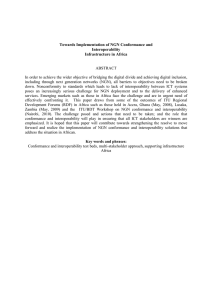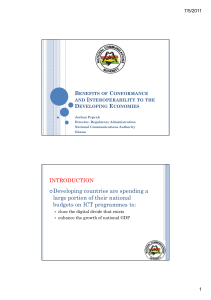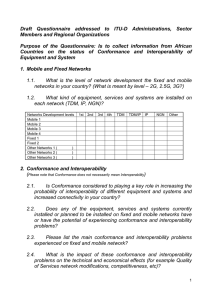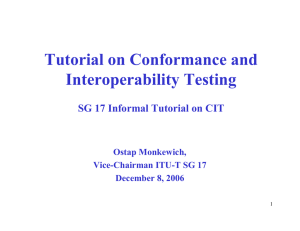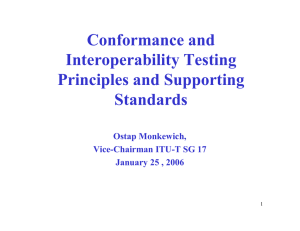Conformance and Interoperability Testing Tutorial ITU-T SG 17
advertisement
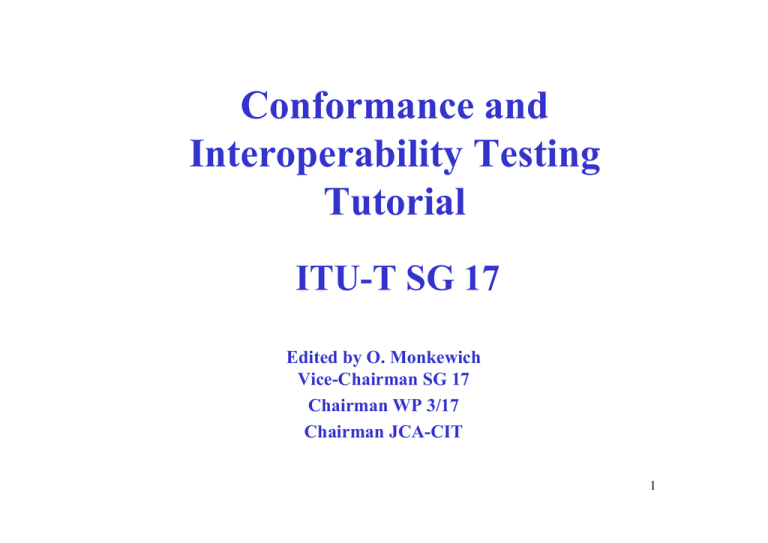
Conformance and
Interoperability Testing
Tutorial
ITU-T SG 17
Edited by O. Monkewich
Vice-Chairman SG 17
Chairman WP 3/17
Chairman JCA-CIT
1
Acknowledgements
In preparing this Tutorial, SG 17 recognizes the special contributions of the
following experts and their organizations
•
•
•
•
•
Ostap Monkewich - Industry Canada and OMCI Consultants
Denis Andreev - Central Research Telecommunication Institute
(ZNIIS), Russian Federation, Q.8/11 Q.3900 editor
Ultan Mulligan - The European Telecommunications Standards
Institute (ETSI)
Stephen Randall - The European Telecommunications Standards
Institute (ETSI) and PQM Consultants
Ina Schieferdecker - Fraunhofer Institute for Open Systems
(FOCUS)
2
CIT Objectives
• Interoperability of products from different
suppliers
• Test the product only once
• Acceptance of test results in different
geographical regions
• Meet regulatory or market driven
requirements
3
How to achieve them
•
•
•
•
•
•
•
•
•
•
•
Recommendations error-free and unambiguous
All use the same terms and definitions
One testing methodology
Requirements and Options listed in point form
Questionnaire on what was implemented, what was not
One set of test purposes
One test suite per standard or Recommendation
Same test verdicts for same tests
Conformance before Interoperability
Accredited test facilities
Certified products
4
Conformance Testing
Methodology Recommendations
•
•
•
•
•
•
•
•
X.290 - General Concepts
X.291 - Abstract Test Suite Specification
X.292 - (Superceded by Z.140 series Recommendations)
X.293 - Test Realization
X.294 - Requirements on Test Laboratories and Clients
X.295 - Protocol Profile Test Specification
X.296 - Implementation Conformance Statements
Z.140 through Z.146 - Testing and Test Control Notation
5
Why Do We Need A Common
Testing Methodology
• All actors must understand each other in all geographical
regions and global markets
–
–
–
–
–
Equipment suppliers
Equipment buyers
Test laboratories
Accreditation organizations
Certification organizations
• Test results must have the same meaning in all global regions
• Test results must be accepted in all global regions
• Time to market - equipment must be tested only once without
the need to retest for different markets
6
Why Conformance to Standards
is important?
• Equipment from different vendors conforming to
the same standards have a higher likelihood of
interoperability
• Different vendors can independently implement
standards with higher assurance of product
interoperability
• Equipment buyers can buy products that will
interoperate with previously purchased
equipment form different supplier
7
Why Interoperability is
important?
• The ultimate objective is that independent
implementations of the same standard
interoperate
• Conformance improves the chances of
interoperability while interoperability
testing checks at a user level if
interoperability has been achieved
8
Conformance and Interoperability
are Complementary
• Conformance to the standard is achieved
first and should not be compromised
during Interoperability testing
• Without conformance, two implementations
can be made to interoperate by destroying
interoperation with all other systems
9
Causes of Interoperability
Problems
• Standards
– Errors and ambiguities in standards
– Incompatible standards (standards with different
QoS, traffic priorities)
• Implementations
– Human errors, e.g. programmer errors
– Different interpretations of the standard
– Different choice of options allowed by the standard
• Technology
– networks use different traffic queuing techniques
– device compatibility
– host system configuration
10
Nature of Interoperability Testing
• Interoperability testing is only meaningful in
single-pair combinations of products
• N interconnected products present (N2 - N)/2
distinct product pair combinations
• Example:
• N = 6 products or 15 pairs
• Each product is tested 15
times
• N = 100 or ~5000 pairs
• Each product is tested 5000
times
11
Nature of Conformance
Testing
• Testing to determine if the product does
what the Recommendation says it is
supposed to do
• Each product is tested only once, against the
standard (represented by the test suite)
Product
Test Suite
12
Standards that Facilitate Testing
ATS
R1
TP1
TC1
R2
TP2
TC2
R3
TP3
TC3
.
.
.
.
.
.
Rn
TPn
.
.
.
PICS
Execution
Test Cases
TC1
TCn
TSS & TP - Test Suite Structure and Test Purposes
ATS:
- Abstract Test Suite
PICS:
- Protocol Implementation Conformance Statement
TC3
.
.
.
PIXIT
PIXIT Information
TSS &TP
PICS Questions
Protocol Standard
Requirements
Clause
TCn
TP - Test Purpose
TC - Test Case
13
R - Requirement
Overview of Conformance
1. Static Review
Testing
2. Dynamic Tests
3. Test Report
Certificate of
Conformance
4. Certification
Implementation with a formal declaration
of which parts of the standard were
implemented
Test Report
STIMULUS
RESPONSE
Implementation Under Test
(IUT)
Test Equipment
and Test Suite
14
Static vs Dynamic Testing
• Static (PICS review)
– what mandatory, optional or conditional features of the
protocol were implemented - declared in the PICS proforma
by the supplier
– PICS becomes a shopping list for finding compatible products
– a car PICS analogy:
• does the car have an ignition system?
• does the car have a steering wheel?
• Dynamic (execution of the ATS)
– behaviour of mandatory, optional or conditional features
– a car ATS analogy
• turn the ignition key, does the engine turn over? Pass, Fail, Inconclusive
• turn the steering wheel, do the front wheels turn? Pass, Fail,
Inconclusive
15
A Requirements Clause from a Standard
Extract from the User-Network Interface (UNI) Specification 3.1
3.3 ATM Cell Structure and Encoding at the UNI
(R)
(R)
(O)
(O)
CPE at the UNI shall encode the GFC value to all zeros
(0000).
Public network equipment at the public UNI shall encode
the GFC value to all zeros (0000).
CPE shall inform Layer Management if a count of the nonzero GFC fields measured for non-overlapping intervals of
30,000 +/- 10,000 cell times reached ten (10) or more.
Public network equipment shall inform Layer Management
if a count of non-zero GFC fields measured for nonoverlapping intervals of 30,000 +/- 10,000 cell times
reaches ten (10) or more.
16
Protocol Implementation Conformance
Statement (PICS) Proforma
Extracted from af-test-0059.000: PICS Proforma for the UNI 3.1 ATM Layer
3.5 Generic Flow Control (GFC) Field
Index
Text
Status Ref.
Values
Support
3.5.1 Does the IUT operate the GFC protocol in
"uncontrolled access" mode, encoding the GFC
field to be all zeros?
M
3.3
__Yes__No
3.5.2 If the IUT is an intermediate node, does the IUT
overwrite any non-zero GFC field received before
sending it into the network?
M
3.3
__Yes__No
3.5.3 Does the IUT, on receipt of 10 or more non-zero
GFC fields measured for non-overlapping
intervals over 30000+/-10000 cell times, generate
an error to layer management?
O
3.3
__Yes__No
17
Static Review
• ICS Proforma - Implementation Conformance
Statement Proforma
– formatted questionnaire for declaring what
optional features have been implemented
– part of the specification or standard
• ICS
– Filled-out ICS Proforma
– A list of requirements and options claimed to
have been implemented
• Used for
– Shopping list for matching products for
interoperability
– Test case selection (from test suite) for
execution
18
Dynamic Tests
• Abstract Test Suite (ATS)
– Defined by a standards organization,
written in an abstract language like
• Testing and Test Control Notation
(TTCN-3), ITU-T Rec. Z.140
• Executable Test Suite (ETS)
– AT .mp file “compiled” to run on
specific test equipment
– creation of the ETS is proprietary to
the test equipment vendor
19
The Local Test Method
There are two PCOs. UT and LT both reside on the Test
System. The upper boundary of the IUT is standardized
hardware interface that plugs into the Test System.
UT Upper Tester
LT Lower Tester
PCO Point of Control and Observation
IUT Implementation Under Test
SUT System Under Test
ASP Abstract Service Primitive
PDU Protocol Data Unit
TCP Test Coordination Procedure
20
The Distributed Test Method
There are two PCOs. The UT is located in the SUT. The LT is
located in the Test System. Access to the upper boundary of the
IUT is required to carry out testing either by human action or a
programming interface.
21
The Coordinated Test Method
There is only one PCO and no UT. UT is integrated with TCP.
The desired effects at the upper boundary of the IUT are
realized by a special TCP called the standardized Test
Management protocol. The method facilitates the highest degree
of automation and security.
22
The Remote Test Method
There is only one PCO and no UT or TCP. The Tester has no
access to the upper boundary of the IUT. The desired effects
at the upper boundary are informally described in the test
suite and are carried out at the SUT by the test operator
23
What is a Test Suite?
• A test suite is a collection of test cases, one for
each test purpose, specified in accordance to the
test method used
• A test case verifies conformance/interoperability
for a particular Requirement or Option
according to the test purpose
Step 1
Step 2
Step 3
Step 4
24
Test Suite Development
• Start with a PICS
– This ensures that complete
coverage is obtained
• Develop Test Suite Structure
– This logically groups the test cases
• Develop Test Purposes
– This defines the objectives of the
test cases
• Write a Test Case for each Test
Purpose
– The test purpose is then included
with its test case in the test suite
25
Test Suite Structure
Test Suite
Test Group
Test Case
Test Group
Test Group
Test Group
Test Case
Test Case
Test Case
26
Test Case Structure
Test Case
Test Step
Test Step
Test Step
Test Event
Test Event
Test Step
Test Event
Test Event
27
Extra Information for Testing
• IXIT - Implementation eXtra Information for Testing
– Additional information required before testing can
proceed
• administrative: identification of client, laboratory staff, IUT,
protocol, test suite
• technical: address of the IUT, timer values, configuration,
parameters, procedures, test cases that cannot be executed
• IXIT Proforma
– Standardized template to be completed by the client and
the test laboratory to produce the IXIT
• PIXIT - Protocol IXIT
– A special case of IXIT, widely used
28
Test Cases, Test Purposes
and Verdicts
• One Test Case for each Test Purpose representing
one Requirement from the Requirements Clause
• To get a Pass verdict, the Implementation Under
Test (IUT) must respond correctly when the Tester
exhibits three different kinds of behaviour:
– Valid
– Invalid
– Inopportune
• For each of the three Tester behaviours, the IUT
may be assigned a Pass, Fail or Inconclusive verdict
29
Test Case Architecture in
TTCN-3
TTCN-3 Test Case
Port.send(Stimulus)
Port.receive(Response)
• Assignment
of a
Test Verdict
Port
System Under Test
30
Sequence Diagram for a Simple
Behaviour Example
msc Example
UA - User Agent SA - Service Agent
UA
loop<100>
SUT - System Under Test
SUT
SA
DATreq("data")
DATind(DT,nr,"data")
DATind(RE,nr,“resp")
DATind()
31
Same Example in TTCN-3
Core Language
testcase Example( )
runs on MTC_Type {
var default mydefault := activate (DefaultDef());
T1.start;
for (integer i:=1; i<=100; i:=i+1) {
UA.send(DATreq:{"data"});
SA.receive(DATind:{DT, nr, "data"});
SA.send(DATind:{RE,nr, “resp”});
UA.receive(DATind :{});
}
setverdict(pass);
T1.stop;}
32
Same Example in Graphical
Format of TTCN-3
testcase Example() runs on MTC_Type
UA
mtc
SA
SA_Type
UA_Type
MTC_Type
var default mydefault :=
activate(MyDefault())
T1
for (i:=1; i<=100; i:=i+1)
DATreq
("data")
DATind
(DT,nr,"data")
DATind
(RE,nr,"resp")
DATind
pass
33
Commercial Tool Example
for TTCN-3
3.Test Data View
1. Test Case Management
6. Test Report Generation
4. Detail Logging
5. Graphical Logging
2. Parameterization
34
Overall Picture
Data
Interface
Generation of
test data structure
Adaptor
follows TRI
and TCI
System
Generation of
test data
Generation of
test behavior
A
D
A
P
T
O
R
Compilation
to Executable Tests
Test
Test
Test
Component
Test
Component
Component
Component
Test
System
35
IP Multimedia Subsystem
(IMS)
Messaging Server
Presence Server
Application Server
IMS
Network Core
36
IMS Testing with TTCN-3
T
E
S
T
•
•
•
•
IMS
SYSTEM
Benchmarking
– for comparison
Load/stress
– how system performs under load conditions
Capacity testing
– max load the system can handle before
failing
Scalability testing
– to plan capacity improvements
Protocol
Conformance
Protocol
Interoperability
Service Conformance
and Performance
37
What Standards are
Missing Today
• For each Protocol
–
–
–
–
–
Requirements Clauses
TSS&TP
PICS and ICS Proformas
PIXIT and IXIT Proformas
Abstract Test Suites
38
Interoperability Testing
• A method for determining
to what extent two or more
implementations function
together for some range of
applications over a
specific communications
medium
39
Specify for Interoperability
• ITU-T I.130 3-stage model for protocol specification
• Requirements
• Functional Architecture and Information Flows
– standardize interoperable interfaces, not internal behaviour
• Detailed protocol specification
– use most relevant techniques: text, UML, SDL, ASN.1, XML
etc.
40
Validate for Interoperability
• Validation through technical reviews and
simulation
• Validation through interoperability events
• Validation through test specification
development
41
Test for Interoperability
• Plan for validation and Plan for testing
• Conformance Testing and Interoperability
Testing
• Use existing methodologies
– X.290 Recommendations, TTCN-3, ISO/IEC 9646,
ETSI Interoperability Testing Methodology
• Validate test specifications
42
Maintain for Interoperability
• Good Recommendations can be broken by poor
maintenance or no maintenance
• Corrections should be made with care
• Extensions require same process as original
development
• Feedback should be sought and captured
43
Basic Interoperability
Concepts
Test Cases
(QE Side)
Test Reports
Logging
Test Coordinator
Qualified
Qualified
Qualified
Equipment
Equipment
Equipment
Test Driver
(QE Side)
Test
Interface
Test Cases
(EUT Side)
Equipment
Under Test
System Under Test
Test
Interface
Test Driver
(EUT Side)
Means of Communication
44
Interoperability Test
Specification
• Specification process steps
– Specify abstract architecture
– Write draft Interoperable Features
Statement (IFS)
– Specify Test Suite Structure (TSS)
– Write Test Purposes (TP)
– Write Test Cases (TC)
– Validate Test Cases
45
Specify Abstract Architecture
• General framework(s) within which concrete
test arrangements must fit
• Can be graphical, tabular or textual
• Should identify:
–
–
–
–
–
EUT
QE(s)
Paths between EUT and QE(s) (MoC)
Valid equipment types for EUT and QE(s)
Expected protocols to be used
46
Write Draft Interoperable
Functions Statement
• An IFS Identifies:
– Functions that an EUT must support
– Functions that are optional
– Functions which are conditional
• The IFS provides structure to the test
specification
• It can also be used like a PICS as a proforma
for a manufacturer to declare which functions
are supported in an EUT
47
Specify Test Suite
Structure
Identify test groups based upon, e.g.:
– Abstract Architecture
– Functionality
– Behaviour:
• Normal
• Exceptional
• Define test coverage for each group
– What range of tests is to be included in each
test group
48
Write Test Purposes
• For each possible test case, describe WHAT is
to be tested
• Use the most appropriate means of expressing
Test Purposes:
–
–
–
–
Plain language
Tables
MSCs
A specialist notation such as TPLan which offers:
• Consistency in TP descriptions
• Clear identification of preconditions, test actions and
verdict criteria
• Checkable syntax
49
Write Test Cases
• Test cases should include:
– Preconditions
• Configuration
• Initial status
– Test steps
• Detailed instructions to Test Driver
– Clear
– Precise
– No unnecessary restrictions
– Verdicts
• “Pass” means “EUT Pass”!
• “Fail” may not mean” EUT Failure”
– QE failure
– MoC failure
– Requires investigation
50
Test Case Specification
• Tabulated free text
– Ideal for implementation by human Test Drivers
– Individual test steps and their relation to each other is easy to
understand
– Only supports simple, serial test path, .i.e, very difficult to describe
alternate paths following an unsuccessful intermediate verdict
• Test language (TTCN-3)
–
–
–
–
–
Ideal for machine implementation of Test Drivers
Highly repeatable
Allows comprehensive handling of unexpected behaviour
Difficult for the human user to read and follow
Establishing a testing environment is complex
51
Sample Tabular Specification
Identifier
TC_SS_0001_01
Summary:
Supervised call transfer from User B to User A
Test Purpose:
ensure that {
when { A call is established between User_C and User_B }
then { User_B can transfer the call from User_B to User_A
after User_B and User_A communicate }
}
TP Identifier
TP_SS_0001
Pre-test
condition
s:
•
•
Step
1
2
3
4
5
6
7
8
9
10
Configuration:
Test Architecture 2
User A, User B and User C configured with Bearer Capability set to "Speech, 64 kbit/s"
User A configured to support the Call Transfer service
Test sequence
Initiate new call at User C to the address of User B
Accept call at User B
Activate the "recall" button (or equivalent) at User B's terminal
Is dial tone (or an equivalent indication) present at User B's terminal?
Initiate a new call from User B to the address of User A
Is User A's terminal alerting (visual or audible indication)?
Accept call at User A
Apply speech at User A
Can speech from User A be heard and understood at User B?
Can speech from User A be heard and understood at User C?
Verdict
Pass
Fail
Yes
No
Yes
No
Yes
No
No
52
Yes
Sample Specification in
TTCN-3 Core Language
// Define Supervised Transfer test case
testcase SupervisedTransfer() runs on userTerminalType
{ timer ResponseTimer := 100E-3;
// Preamble: Establish call between Users B & C
m3s.send (CallEstablish_1);
m2s.receive (CallEstablish_1);
m2s.send (CallAccept_1);
m3s.receive (CallAccept_1);
// Register recall test
m2s.send (Recall);
ResponseTimer.start;
alt
{ [] ResponseTimer.timeout
{ setverdict(fail);
stop
}
[] m2d.receive (DialTone)
{ setverdict(pass);
ResponseTimer.stop
// Hold call test
.......
53
Sample Specification in
TTCN-3 GFT
54
Interoperability Testing Standards
• Z.itfm series Recommendations on Methodology
–
–
–
–
work in progress
two major contributions - ETSI, Korea
similar methodology to X.290 Recommendation
some new concepts are being discussed
• Standards to be produced as required by Z.itfm
–
–
–
–
–
Requirements Clause
Test Suite Structure and Test Purposes (TSS&TP)
Implementation Conformance Statement (ICS)
The Abstract Test Suite
Implementation eXtra Information for Testing (IXIT)
55
Configuration of a Model Network
Q.3900 Recommendation identifies model network configuration for NGN testing
56
Model Networks can help Development of
CIT Recommendations
Access Layer
Wi-Fi
Wi-Fi,
WiMAX
Radionet
RN 700
Radionet
RN 800
Radionet
RN 700
Wi-Fi
Radionet
RN 820
xDSL
NGN Layer
MGW Alcatel 7515
MGW Alcatel 7515
MGC
Alcatel
5020
HE
CPE
PLC Sumitoma
IP Layer
PSTN Layer
Huawei Quidway 3600
GK
Huawei Quidway 3600
Huawei Quidway 3600
SI-2000
Huawei Quidway 3600
S-12
ECI XDM-2000
ECI XDM-2000
ECI XDM-2000
SDH Layer
ECI XDM-2000
57
Testing Methods for Model Networks
Possible NGN Test Methods when using Model Networks
Functions testing
Conformance testing
Functional testing
Database
Interconnect testing
Load&Stress testing
End-to-End testing
Database
NGN TM testing
QoS testing
Services testing method
Mobility testing
NUT testing method
58
Trusting the Test Results
• Who does the testing
– Third-party testing (independent test laboratory)
– Second-party testing (product procurer or user)
– First-party testing (product supplier)
• Testing can be made formal enough for
certification of tested products
59
Adding Confidence
• Accreditation
– checks for competence to carry out testing
– checks for competence to issue certifications
• Certification
– checks for conformity to a quality system standard
– checks for conformance to the protocol standard
• Test Laboratories
– Carry out testing
– Prepare the Test Report
60
Conclusions
• To the writers of Recommendations:
– Specify for Interoperability (Requirements, Functional Architecture,
Protocol Details)
– Validate for Interoperability (Technical Reviews, Interoperability Events,
Test Specifications)
– Test for Interoperability (Plan, Conformance and Interop., Use X.290 and
Z.140 series Recommendations, Validate Test Specifications)
– Maintain for Interoperability (Good standards are broken by poor
maintenance, Make changes with care, Use well defined process)
• If the above is not done, it is too late for interoperability
• Supporting standards for conformance and interoperability
testing do not exist but must be developed
• Standards should be tested for errors and ambiguities prior to
approval (as is done in IETF)
61
